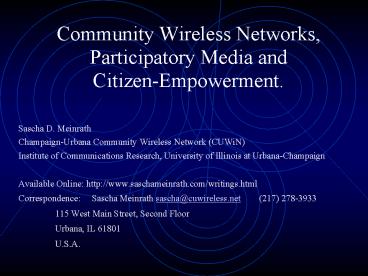Community Wireless Networks, Participatory Media and CitizenEmpowerment. - PowerPoint PPT Presentation
1 / 24
Title:
Community Wireless Networks, Participatory Media and CitizenEmpowerment.
Description:
1920s Radio. Post WWII Television/Public Access TV. Today Broadband (Internet) Connectivity ... producer broadcasting Internet radio, self-publishing ... – PowerPoint PPT presentation
Number of Views:52
Avg rating:3.0/5.0
Title: Community Wireless Networks, Participatory Media and CitizenEmpowerment.
1
Community Wireless Networks, Participatory Media
and Citizen-Empowerment.
- Sascha D. Meinrath
- Champaign-Urbana Community Wireless Network
(CUWiN) - Institute of Communications Research, University
of Illinois at Urbana-Champaign - Available Online http//www.saschameinrath.com/wr
itings.html - Correspondence Sascha Meinrath
sascha_at_cuwireless.net (217) 278-3933 - 115 West Main Street, Second Floor
- Urbana, IL 61801
- U.S.A.
2
Overview
- What are Community Wireless Networks?
- Mesh CWN example CUWiN.
- What are the social/community benefits and
technological possibilities? - How do the technologies work and what are the
different options available? - Where can I find out more?
- But first (literally)
3
Community Media Historically
- 1700s Newspapers
- 1840s Telegraph
- 1900s Telephone
- 1920s Radio
- Post WWII Television/Public Access TV
- Today Broadband (Internet) Connectivity
4
Community Wireless Networks
- Small, usually non-profit, unincorporated,
municipally supported, hybrid partnerships - Locally based
- Usually utilize off-the-shelf hardware, low-cost
- Action-oriented
- Mission to support social economic development
- Highly experimental
5
CUWiNs 4-Part Mission
- Connectivity
- Provide Internet connectivity to network users.
- Development
- Program software and build hardware for use by
other wireless projects throughout the United
States and around the globe. - Dissemination
- Distribute open-source software and hardware
specs to interested people and organizations. - Implementation
- Build and support sustainable, not-for-profit
communications networks in communities throughout
the world.
6
Social Benefits for Residents
- Every citizen has the opportunity to be a media
producer broadcasting Internet radio,
self-publishing journalism, displaying art
projects, etc. - Churches can webcast religious services make
spiritual resources available online. - Local libraries can become a hub for free, open
access to information. Parks, swimming pools,
beaches, sports facilities, airports, train
stations, and other public areas can provide
Internet access to users of these areas. - Free wireless kiosks can be placed strategically
around a municipality to provide information to
tourists, visitors, and residents.
7
Social Benefits for Educators
- Universities, colleges, and K-12 classrooms can
cheaply establish wireless networks creating
tremendous infrastructure and maintenance savings
versus wired networks. - Teachers can design lesson plans collaboratively
with other classrooms, track student progress,
and record grades on parent-accessible websites. - Students can publish online newspapers/blogs,
create a school web-radio station, or web-cast
news produced in multimedia classrooms. - Bridging the digital divide low-cost wireless
offer schools high-tech resources, as well as
additional opportunities for adult education and
distance learning.
8
Social Benefits for Public Health
- Health-care providers can transfer information to
patients with limited mobility as well as
exchange patient information among doctors,
clinics, pharmacies, and hospitals. - Mobile home healthcare workers and social workers
can more easily chart their daily rounds and
retrieve and send information to better serve
patients. - Physical therapists can demonstrate specific
exercises to patients watching from their homes. - Nursing homes can provide residents with
entertainment, educational opportunities, and
easy communication with family and friends.
9
Social Benefits for Government
- Wireless networks facilitate e-government
initiatives such as online voter registration,
directions to polling stations, bill payment,
access to tax advice, and public service
announcements. - Unemployment and social services offices can
collect and disseminate information about job
opportunities, job training, and child care
facilities available in a community to those in
need. - First responders and law enforcement officers can
send data, audio, and digital video to command
centers for evaluation and rapid response. - CWNs can be utilized as a local broadcaster to
webcast town meetings, city council sessions,
local speeches, or cultural events.
10
Social Benefits for Business
- Wireless infrastructures offer job creation
opportunities as businesses take advantage of
lower barriers to market entry and the advantages
of high-speed, low-cost communications. - CWNs promote mobile workforces with on-demand
information access at all points across a town or
city. - CWNs allow for cost-effective marketing
strategies and new ways to present points of sale
to targeted customers. - CWNs create opportunities to increase broadband
penetration, expanding options for reaching
commercial audiences.
11
CWN Technologies
- Wired vs. Wireless
- Hub Spoke vs. Mesh
- Closed vs. Open
- Static vs. Dynamic
12
Wired Networks
- 1840s technology
- Expensive
- Disruptive
- Entrenched
13
Wireless Networks
- Cheap
- Non-invasive
- Mobile/Portable
- Ubiquitous?
14
Hub Spoke Networks
- Centralized
- Relatively expensive
- Line of site
- Bandwidth-intensive
- High-power
- Single point-of-failure
15
Mesh Networks
- Decentralized
- By-passes obstacles
- Relatively cheap
- Low-power
16
Closed Networks
- Proprietary
- Expensive software
- Immature technology
- Factionalizes communities
17
Open Networks
- More secure
- Cheap/free software
- Open source
- Allows community resources on the network
18
Static Networks
- Fragile
- Non-scalable
- Time-intensive
19
Dynamic Networks
- Robust
- Scalable
- Adaptable
20
The Rationale Behind Community Wireless Networks
I
Christian Sandvig
- Low SES
- Medium Density
- Government Subsidized Housing
21
The Rationale Behind Community Wireless Networks
II
Christian Sandvig
- Medium SES
- Medium Density
- Immigrant Community
22
The Rationale Behind Community Wireless Networks
III
Christian Sandvig
- High SES
- High Density
- Young Professional Neighborhood
23
Conclusions
- CWN technology is accessible.
- CWNs are a viable technological alternative.
- CWNs are a cheap deployment option.
- CWNs offer more services to end users.
- CWNs are cheaper for end-users.
- Like the Internet itself, CWNs create new media
production and information dissemination
opportunities limited only by our own
imaginations.
24
For More Information
- Sascha D. Meinrath CUWiN Free Press
- sascha_at_cuwireless.net www.cuwireless.net www.freep
ress.net/wifi - Power Point presentation will be available online
at - http//www.saschameinrath.com/writings.html

